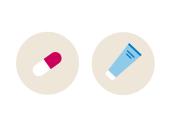Scabies, or ‘the itch’, is a contagious skin disease caused by the itch mite. Scabies can be treated with a special cream or with tablets.
Treating scabies
Both Permethrin cream and Ivermectin tablets are an effective way to treat scabies. It is important to keep in mind that everyone around you who may have also caught scabies must be treated at the same time as you.




